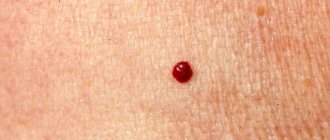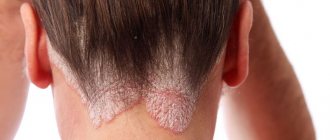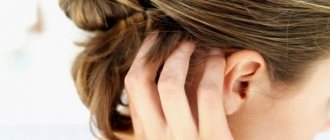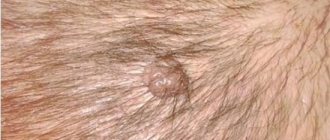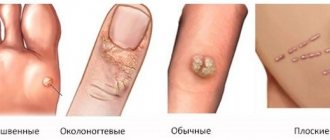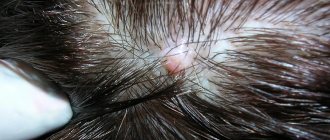May 4, 2020 Warts
Many people strive to get rid of small skin growths on their hands, but sometimes dermatological pathology manifests itself not only in these areas. How to remove a wart on the head if it is often injured by a comb or turns red from washing with shampoo? Dermatologists know the answer to this question and will select the appropriate method for each specific case.
Why does a wart appear on the head?
Convex nodules grow throughout the body, including the scalp, due to infection of the body with the papilloma virus. Almost every person has it in an inactive state, but under the influence of negative factors it begins to actively multiply, causing dermatological formations. Their formation is accompanied by physical and aesthetic discomfort, and can sometimes cause serious health problems.
A wart on the head in the hair can remain invisible for a long time until it is injured. Then pain appears, and even bleeding occurs. Such nodules have different sizes and shapes, they can be convex, pedunculated, flat and of different shades, from light beige and almost transparent, to brown-brown or black.
Their growth begins under the influence of the following provoking factors:
- frequent stressful situations;
- gastrointestinal diseases;
- suffered serious infections;
- bad habits;
- taking certain medications;
- weakening of immune forces;
- poor diet;
- overweight;
- profuse sweating;
- hormonal disorders;
- unfavorable ecology.
Such prerequisites cause the growth of warts on the head under the hair, a photo of which can be viewed on the Internet. This keratinized compacted formation is usually small in size and does not cause discomfort if it is not damaged.
Lumps under the hair can be single or appear en masse. The risk of tearing and damage is higher than in other areas of the body, since hair is often styled, cut, combed, and dyed with unsafe dyes. Often, viral warts on the head directly under the hair go away on their own if the immune system has been restored or it has been strengthened with the help of vitamins and hardening procedures.
Treatment options
There is a wide range of methods for removing formations on the head and other parts of the body. When carrying out such procedures, it is important to additionally eliminate the causes of formations.
The main factor contributing to their development is considered to be a reduced level of immunity, so it is recommended to improve your health by taking interferon-based medications.
Pharmaceutical preparations – ointments, creams, tablets
The principle of using pharmaceutical drugs for warts is not complicated.
Wart ointment and cream are applied to the surface of the wart in accordance with the instructions, and the procedures are repeated until the growth completely disappears. Products based on salicylic acid (Salipod patch, creams, ointments) are especially effective
Additionally, immunostimulating drugs such as Viferon are taken.
Warts on different parts of the body (not just on the head) can be removed using:
Folk remedies
In folk medicine there are many recipes against warts.
Acetic acid is considered one of the most effective folk remedies against warts. The substance should be dripped one drop daily onto the growth and within a few days or weeks it should die off.
Other traditional medicine for warts on the head:
- daily lubrication with fresh juice of cabbage leaves;
- rubbing the wart daily with regular chalk;
- Lubricate the growth with castor oil twice a day;
- applications (daily) based on a decoction of wormwood.
Works well on warts:
By the way, based on the latter, there are many pharmaceutical products for removing papillomas; Super Clean is considered one of the cheapest and most effective.
How is a viral wart neoplasm different?
If a vulgar wart appears on your head, its photo looks very similar to a small growth, then most likely it is of viral origin. At the initial stages, benign neoplasms have a pinkish or beige tint, a round shape and a small diameter. Over the years, they gain dark pigment and become brown or grayish-yellow. Several growths may merge together. They look like warts on turkeys' heads and cause serious discomfort.
Vulgar growths have a dense, rough surface and are localized on the facial area, feet, head and hands. Juvenile nodules occur during hormonal changes and in children infected with HPV. These are small polygonal or oval plaques. Soft growths appear on the neck or under the arms, similar to pedunculated mushrooms, cockscombs or cauliflower.
As you can see, the disease has various forms, the main thing is to distinguish wart nodules from moles:
- Birthmarks do not spread to other areas of the body.
- A wart, unlike a mole, has a tendency to change color, merge with other plaques, and increase in size.
- Hairs never grow from vulgar nodules; there is no skin pattern on their surface.
HPV infection occurs through sexual or household contact. Under certain conditions, the virus infects the epidermis, where increased growth of keratinized cells is triggered. It can take decades from the moment of HPV infection to skin manifestations.
To accurately determine what has grown on the scalp, a dermatologist carefully examines the formation and prescribes additional tests (blood test, tissue plucking for laboratory control).
Types of nevi
Nevi appear throughout life, there is nothing special about it, on any part of the body and on any side of it. Many people have symmetrically located nevi, for example, one mole on the right cheekbone is absolutely identical to the same one on the left cheekbone. The appearance of new nevi is associated with the accumulation of pigment, which is contained under the epidermis, but in some skin cells there is a lot of it. Essentially, pigmented spots are made up of pigment-filled skin cells. The accumulation of such pigments is caused by a malfunction in the development of the skin, therefore congenital nevi are malformations of the skin, and acquired nevi are benign skin tumors.
So, the first classification of nevi:
- safe (not susceptible to degeneration),
- melanoma-hazardous (high risk of melanoma formation).
- traumatic (on the palms, feet, waist, collar area),
- not dangerous (mole on the temple, arms, legs, etc.).
The most serious classification of nevi is:
- Pigmented nevi. These are the brown spots on the body that many people are familiar with. They can be smooth, hairy or have an uneven surface. In fact, such nevi are skin cells and contain excess melanin, although they also contain skin nerve cells;
- Warty formations. These are nevi, which are often confused with warts, which is why they got such an interesting name. The color of such spots ranges from blue to dark, completely black. These are convex birthmarks that can be easily injured and degenerate;
- Vascular moles. A completely different type of nevi, they can be red or pink in color. The surface of such spots is uneven (rough, granular). These are raised small nevi that mature in the lower layers of the skin. Such moles include vessels, hence the name of the formations.
A slightly different classification stands out today as popular:
- Flat nevi. These are ordinary spots of black or brown color. They are considered the most common, but also safe. These are absolutely symmetrical nevi with a smooth surface. As a rule, they are small;
- Convex moles. Most often these are brown protruding formations. The surface can be flat or uneven. It’s not scary if hairs grow from a convex nevus;
- Hemangiomas or vascular neoplasms. These are red and pink nevi that originate from blood vessels;
- Large pigment spots. Often these are congenital nevi; they can have any size, up to giant ones, any shape and color (the color is most often brown).
- Blue nevi. They can have colors from blue to the darkest. So the purple mole “sits” very deep, hence its color. The outer surface of the neoplasm is convex and uneven.
Removing warts on the head at home
Horny growths under the hair should be removed if they:
- bring painful sensations;
- become inflamed and itchy;
- began to bleed;
- sharply increased in size and changed color;
- bring psychological discomfort.
To eliminate growths from a special zone, medications are used:
- immunomodulators;
- antitumor agents;
- adaptogens;
- antioxidants;
- vitamin complexes.
These can be tablets, capsules, injection solutions, suppositories with an antiviral effect, for example, Interferon, homeopathic suppositories Viferon, Cycloferon .
Pathological seals can also be affected by external methods, that is, various aggressive liquids. Phenols and alkalis, trichloroacetic acid, lactic acid, and salicylic acid have a strong effect on eliminating wart nodules under the hair. Among pharmaceutical drugs that are especially effective against growths on the head:
- Antipapillomas;
- Verrucacid;
- Super Celandine;
- Fresol;
- Dermavit;
- Collomak.
Some of them burn out pathological cells, while others have a freezing effect, for example, Wartner cryo aerosols, Cryopharma . At home, a small wart on the scalp, the photo of which is completely invisible, will disappear if it is treated with castor oil, povidone-iodine , celandine or onion juice, and salicylic acid. balm Papilek and Mountain Celandine , which contain only natural ingredients without synthetic additives, are quite helpful for dermatological pathologies
Is it worth removing a nevus and how?
Whether to remove pigmented spots is a valid question. If a new growth on the skin does not bother you at all, then this is not necessary, but if a mole suddenly swells, begins to grow, or exhibits other suspicious symptoms, then you should undergo surgical intervention. However, you can choose the method to remove the skin lesion yourself:
- Surgical excision. The skin is cut with a scalpel and the tumor is excised. Wide or sparing excision may be used depending on the type of nevus and its location. In this case, stitches are placed on the wound, but for the most part sick leave is not required;
- Laser excision. The laser beam carefully but quickly cuts off the skin tumor layer by layer. The method is suitable for excision of nevi on any part of the body. And the removal of moles on the temple or face is, in principle, safe and recommended, because no traces of the operation remain;
- Cryodestruction. With this method, the mole is injured, or rather the skin cells are destroyed by liquid nitrogen. The method is very good and effective, but the skin takes a very long time to heal after such a procedure, about 2-3 months, while after other methods it takes 4-6 weeks;
- Electrocoagulation. This procedure uses electric current. The disadvantage of this method is the possibility of causing a thermal burn to the skin.
Surgical removal of wart nodules
Radical action is necessary if neoplasms cause discomfort. They are removed using the following modern techniques:
- radio waves;
- electrocoagulation;
- laser;
- cryodestruction (exposure to liquid nitrogen).
Most often, those who are faced with the problem of wart growth under their hair choose liquid nitrogen or laser burning. These are safe and painless ways to get rid of a cosmetic defect. A wart on the head in the hair will disappear without a trace, a photo of the results of the operation is proof of this. Tissue structures are quickly restored after surgery, and scars and cicatrices are eliminated. The main thing is proper postoperative care.
Many women are wondering if a wart on the head is removed, can they dye their hair? The answer is simple - such procedures are excluded during the rehabilitation period. Only after the complete restoration of healthy skin without redness and swelling is it possible to correct the hairstyle as desired.
What types of warts are there: features of occurrence and treatment
Previous post
CLEAN FORTE for papillomas and warts: targeted treatment without harm to health!
Next entry
Prevention
Following several recommendations from dermatologists will help you avoid the appearance of warts:
- Treatment of wounds and cuts on the skin with antiseptic agents.
- When working with chemicals that can damage the integrity of the skin, you must use gloves.
- Wear clothes and shoes made from natural materials.
- Enrich your diet with foods containing vitamins, minerals and all proteins necessary for the structure of cells and tissues.
- When in contact with people who already have warts, you should limit the use of shared objects and wash your hands with soap frequently.
- Carefully observe personal hygiene measures in public places and catering outlets. Mandatory hand washing with soap after walking, any exit from the house, or visiting the restroom.
We invite you to familiarize yourself with Home life hacks: how to cure calluses on your feet
Although warts do not cause any additional pathologies, they require treatment. You should not put it off when there are many simple folk and a number of more modern effective ways to get rid of an unpleasant aesthetic problem without leaving home. It is best, of course, to consider freezing with liquid nitrogen using the pharmaceutical drug Veruclin. Which will not only destroy warts in one procedure, but also will not leave marks or scars on the skin.
Warts. Why and how they appear
If you find an error, please highlight a piece of text and press Ctrl Enter.
Symptoms and diagnosis
There are no special factors for the prevention of papillomatous formations
In order to effectively carry out a high-quality process of removing these benign growths on the scalp, it is extremely important and necessary to establish an accurate diagnosis. Diagnostic techniques are simple and do not pose much difficulty, but the diagnosis must be carried out by a specialist - an oncologist or a dermatologist. Usually, the decision on how to treat is preceded by a visual and specialized diagnosis of the pathology. In order to remove various neoplasms, a histological examination of the wart materials should be carried out. The treatment is prescribed by the doctor, and it is as follows:
- The most successful way to remove warts on the neck and other local areas of the human body is treatment with a cooling method - frozen nitrogen or electricity.
- Laser treatment is also acceptable for the most difficult and complicated situations.
- Treatment for a disease where there is a wart on the neck can traditionally be surgical with the use of instrumental intervention, but this is the usual method of treatment used in extreme cases.
You should not neglect folk methods and recipes when treatment is based on the use of herbs - St. John's wort, celandine, garlic and other time-tested methods.
As far as modern medicine knows, there are no special factors for preventing the appearance and growth of papillomatous formations today. The main aspect can be called control of one’s own health, proper nutrition, a normal lifestyle and an almost complete renunciation of bad habits. It is also important to observe the rules of hygiene, timely care of the skin of the face and head, as well as the correct selection of cosmetics and preparations for the care of the skin of the body and head.
